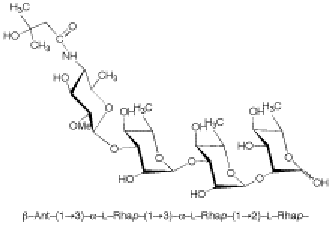Wednesday, 16 May 2007 - 2:30 PM
208 (Pfahler Hall)
125
Neoglycoconjugates from the synthetic tetrasaccharide side chain of the Bacillus anthracis exosporium
Anthrax is a serious infectious disease of animals and humans caused by Bacillus anthracis. Recently, concerns regarding anthrax have emerged worldwide because of possible use of some form of Bacillus anthracis as a biological weapon. Therefore, development of a potent vaccine for anthrax has become a pressing issue. Bacillus anthracis is a spore forming bacterium and, therefore, a potentially viable approach to control anthrax is by targeting spores with neutralizing antibodies specific for substances on their surface. Such is, for example the tetrasaccharide (see structure attached) of the side chain of the collagen-like region of the major glycoprotein (BclA) of Bacillus anthracis exosporium, whose structure has been recently determined. The tetrasaccharide is unique in that it contains the newly discovered sugar anthrose ([4,6-dideoxy-4-(3-hydroxy-3-methylbutyramido)-2-O-methyl-D-gluco-pyranose] as the upstream terminal moiety. Our approach to a vaccine for anthrax is based on the use of neoglycoconjugates prepared from the said tetrasaccharide. In order to obtain optimal immune response after immunization with neoglycoconjugates prepared from the tetrasaccharide, the anomeric configuration of the terminal, downstream L-rhamnosyl residue in the conjugates must be the same as in BclA glycoprotein. That information is unknown, as it was lost during the enzymatic release of the tetrasaccharide from the glycoprotein. This presentation will be focused on our synthesis of a glycosyl donor for latent anthrose, its use to chemically synthesize both anomeric forms of the linker-equipped, conjugation-ready tetrasaccharide, and conversion of these substances to neoglycoconjugate constructs with pre-determined carbohydrate-protein ratio using squaric diester chemistry. Various general aspects of conjugation of carbohydrates to proteins will also be discussed.
Back to Carbohydrate Chemistry/Glycoprotein
Back to The Middle Atlantic Regional Meeting (May 16 - 18, 2007)
